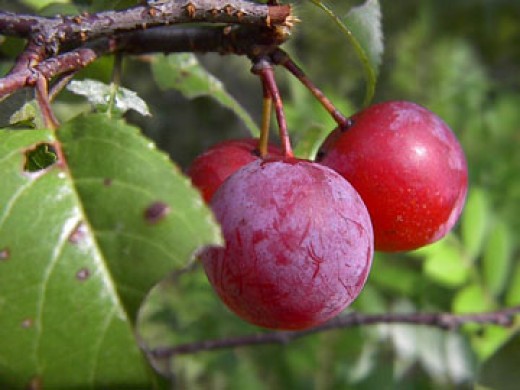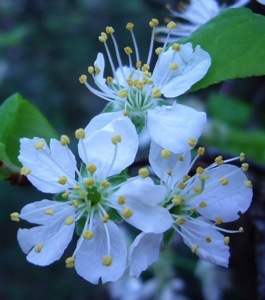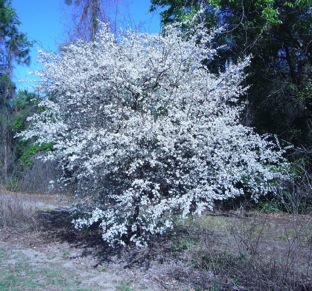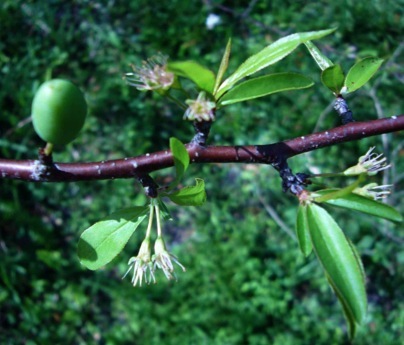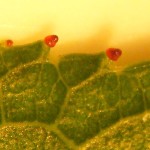Chickasaw Plum: First Springtime Blossom
Every spring, three wild plums put on a show locally: The Chickasaw, the Flatwood, and the American. They burst out in white blossoms and no leaves.
When in naked bloom they look similar but that’s where the resemblance stops. The Chickasaw and the American go on to produce consistently edible plums whereas the Flatwood’s fruit can range from extremely bitter to sweet. Telling these plums apart before they fruit is a bit of a guessing game.
If you have skinny leaves it is either the Chickasaw or Flatwood. If the tips of the teeth on the leaves have yellow or red glands (you’ll need a hand lens) it is the Chickasaw, otherwise the Flatwood. If you have fat leaves with a strong pointed tip, it’s the American though it is not common here. Locally the fruit of the Chickasaw (Prunus angustifolia) ripens to a sweet red in the spring and is gone by early July. It often forms a thicket.
The Flatwood (Prunus umbellata) which often stands alone, ripens to black or yellow and can be around through the summer into the fall. The American (Prunus americana) tends to fruit in late summer to early fall and has red fruit. The fruit of the Flatwood often remains amazingly bitter and hard even after months on the tree. Settlers used it to make jellies or fed it to livestock, hence its other common name, Hog Plum though there are several “hog” plums. Native Americans and settlers, however, regularly ate of the American and Chickasaw plums, the latter developing very sweet fruit with a tang. The first foragers used the plums fresh and dried for winter use. Some tribes took out the seed kernels, others didn’t. Let’s talk about that.
Liberated from their shells the sunflower-sized kernels of these plums can create cyanide in your gut. Very small amounts don’t bother us but we are not talking about small amounts. Natives would make cakes out of the kernel mash. Letting the cakes set for a day or so allowed enzymes to work on those chemicals as did subsequent cooking, making the cake edible… or at least that is the explanation experts give. That strikes me as a lot of work for such a small amount of food that’s potentially toxic. That said they could have been a treat, a flavoring, an essential macro nutriment — oil — to make them worthwhile or a micro-nutriment. Calories are not the only reason to forage.
In the 1800’s there was great interest in making cultivars out of native plums and by 1901 there were over 300 of them. But mechanization of fruit production in the early 1900’s led growers away from the native varieties though there has been some interest of late to use the native plums again as a high-value specialty crop.
Besides man the Chickasaw Plum’s fruit is eaten by deer, bear, fox and raccoon. The thorny thicket is valuable for songbird and game bird nesting including the bobwhite and mockingbird. It also makes a good wind break and can be used for erosion control. The plum, extensively used, was taken everywhere by the Chickasaw Indians and it has many local names. While usable, the Flatwood Plum, is not prime foraging food. Its quality can vary from tree to tree, rarely rising to the gustatory level of the Chickasaw Plum. The American Plum was also used by the natives.
The Chickasaw Plum is one of my favorite trail and yard nibbles. As to its botanical name Prunus angustifolia. Prunus (PROO-nus ) is the Roman name for the plum. Angustifolia (an-gus-tee-FOH-lee-uh) means skinny leaf (see photo directly above.) Umbellata (um-bell-LAY-ta) means like an umbrella for its shape. Americana (ah-mare-ree-KAY-na) means American. “Chickasaw” is Choctaw for “old” and “reside” or as we might say in English, “the old place.” Incidentally, the Chickasaw Plum is native to Texas and Oklahoma but is naturalized through much of the United States where there are sufficient winter chill hours, such as central Florida north.
The Chickasaw plum and the American plum are closely related and hybridize easily. That means… yep, you guessed it. You can find plums in the wild which display some characteristics of each and can be impossible to identify.
Green Deane’s “Itemized” Plant Profile
IDENTIFICATION: Chickasaw Plum: Small thorny tree to 25 feet, usually much smaller, flower small, under half an inch, 5 white petals, fragrant; reddish orange anthers, appear in clumps in early spring before the leaves, fruit bright yellow to red, round to oval, 1/3 to 1/2 inch in diameter, flesh juicy small plum, bark first smooth and reddish then with numerous elongated light horizontal hash marks. The leaf has a center troth. The teeth have yellow or red glands on the tip. Some times the fruit can stay green yet ripens to sweet.
TIME OF YEAR: Late spring in Florida, late summer farther north, usually around September. Locally the Chickasaw Plum is done fruiting long before the 4th of July. The Flatwood Plum can have fruit persisting into the fall.
ENVIRONMENT: The Chickasaw forms thickets in open areas, any open space in scrub forest, sandy soil, roadsides, fences, prairies, Pennsylvania west to the Rockies, south south to Central Florida, also California. Easily transplanted or grown from seed. It requires some chilling so won’t grow in South Florida and similar climates. The Flatwood is often a stand alone.
METHOD OF PREPARATION: Chickasaw: Cherry-size plum, out of hand or for jelly, pies, preserves and wine. It makes a tart, bright red jelly. The Flatwood was used to make jellies or to add to other jellies. It is usually too sour and hard to eat out of hand.

